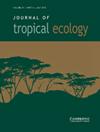利用卫星数据评估保护区现状和保护立法在热带森林保护中的效用:以泰国大犀鸟为例
IF 1
4区 环境科学与生态学
Q4 ECOLOGY
引用次数: 2
摘要
保护野生动物及其环境不受人为活动的影响,需要确定和建立保护区,并监测其对野生动物及其栖息地的长期影响。热带森林是最危险的栖息地之一,由于人类活动,许多热带物种最近已经灭绝。必须监测保护区内外的栖息地,以便确定优化保护成果的战略和立法政策。为此,我量化了1973年、1985年和1992年泰国Om Koi野生动物保护区大犀鸟(Buceros bicornis)在保护区建立前后和保护区内外的栖息地破碎化,以评估1978年建立的保护区状况和1989年建立的国家伐木禁令在保护和恢复犀鸟栖息地方面的有效性。结果表明,与保护区外相比,严溪野生动物保护区的建立并没有降低犀鸟栖息地的破碎化率。虽然保护区开始时碎片化程度较低,但保护状态并不影响损失率。在保护区建立后的第一个时间点和第二个时间点之间,保护区内外破碎化程度均显著增加(p < 0.05)。然而,1985年实施的国家禁止采伐政策似乎成功地阻止了保护区内和周围未保护区内栖息地的破碎化,所有地区都没有明显变化(p > 0.05)。虽然不显著,但保护区外的破碎化率更高。这表明,仅仅建立保护区可能不足以阻止或扭转对濒危栖息地和利用这些环境的物种的人为破坏。可能需要结合多种管理战略,以提高保护区保护热带森林物种和生境的能力。通过卫星和地面数据对保护区进行评估是评估保护策略有效性和改善结果的重要工具。本文章由计算机程序翻译,如有差异,请以英文原文为准。
Evaluating the utility of protected area status and conservation legislation in tropical forest conservation using satellite data: a case study of the great hornbill in Thailand
Preserving wildlife and their environment from anthropogenic activities requires identification and establishment of protected areas, and monitoring of their long-term effects on wildlife and habitat. Tropical forests are one of the most at-risk habitats and many tropical species have become extinct recently due to human activity. It is imperative to monitor habitat in protected areas and without in order to identify strategies and legislative policies that optimize conservation outcomes. To this end, I quantified habitat fragmentation for the great hornbill (Buceros bicornis) in Om Koi Wildlife Sanctuary, Thailand, pre- and post-establishment, within and outside the protected area, from 1973, 1985, and 1992, to assess the effectiveness of the protected area status, established in 1978, and a national logging ban, established in 1989, in preserving and restoring hornbill habitat. The results demonstrate that the establishment of Om Koi Wildlife Sanctuary did not decrease the rate of hornbill habitat fragmentation relative to areas outside the protected area. While the protected area had less fragmentation to begin with, protection status did not affect the rate of loss. Fragmentation increased significantly both inside and outside the protected area between the first and second time points (p < 0.05), after the protected area was first established. However, the national logging ban policy implemented in 1985 seems to have successfully halted the fragmentation of habitat within the protected area and surrounding unprotected areas, with all areas showing no significant change (p > 0.05). While not significant, the rate of fragmentation outside the protected area was greater. This suggests that the establishment of a protected area alone may not be sufficient to stop or reverse anthropogenic damage to endangered habitat and the species that utilize these environments. The incorporation of multiple strategies for management is likely needed to increase the ability of protected areas to preserve tropical forest species and habitats. The assessment of protected areas via satellite and ground-level data is an essential tool for evaluating the effectiveness of conservation strategies and improving outcomes.
求助全文
通过发布文献求助,成功后即可免费获取论文全文。
去求助
来源期刊

Journal of Tropical Ecology
环境科学-生态学
CiteScore
2.10
自引率
0.00%
发文量
44
审稿时长
18-36 weeks
期刊介绍:
Journal of Tropical Ecology aims to address topics of general relevance and significance to tropical ecology. This includes sub-disciplines of ecology, such as conservation biology, evolutionary ecology, marine ecology, microbial ecology, molecular ecology, quantitative ecology, etc. Studies in the field of tropical medicine, specifically where it involves ecological surroundings (e.g., zoonotic or vector-borne disease ecology), are also suitable. We also welcome methods papers, provided that the techniques are well-described and are of broad general utility.
Please keep in mind that studies focused on specific geographic regions or on particular taxa will be better suited to more specialist journals. In order to help the editors make their decision, in your cover letter please address the specific hypothesis your study addresses, and how the results will interest the broad field of tropical ecology. While we will consider purely descriptive studies of outstanding general interest, the case for them should be made in the cover letter.
 求助内容:
求助内容: 应助结果提醒方式:
应助结果提醒方式:


